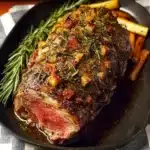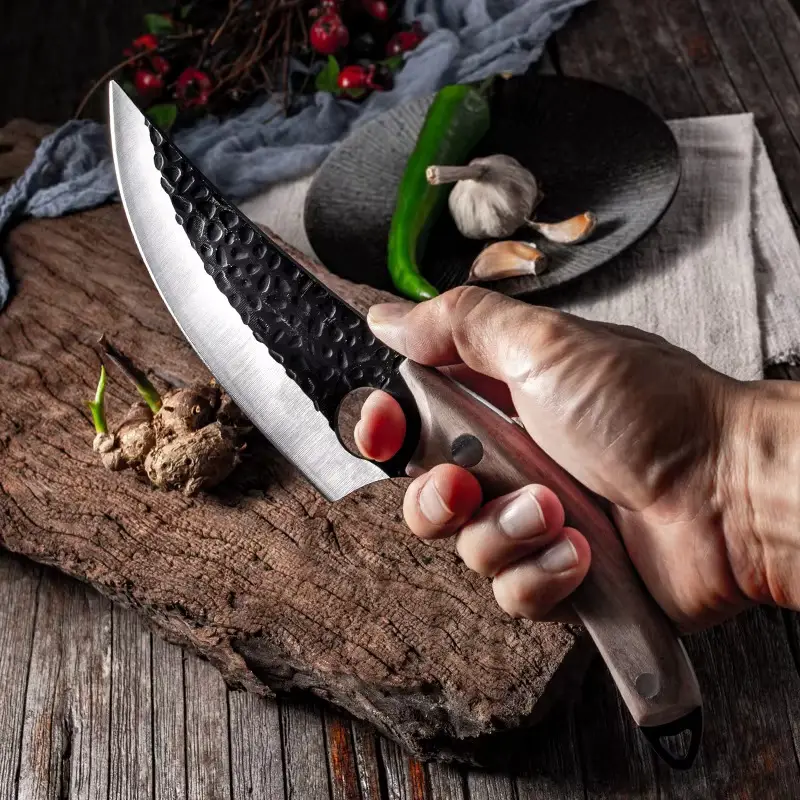There’s something undeniably comforting about the aroma of a Sunday roast wafting through the house. For years, our family Sundays were synonymous with roasted chicken, a dependable classic. But lately, I felt a yearning for something a bit more… celebratory. Enter the Roast Rosemary Leg of Lamb. I stumbled upon this recipe during a late-night online browsing session, drawn in by the simplicity of the ingredients and the promise of herbaceous, savory goodness. Let me tell you, this recipe wasn’t just a hit; it was a home run. From the moment the lamb emerged from the oven, its skin beautifully browned and glistening, the kitchen filled with the intoxicating scent of rosemary and garlic, I knew we were in for a treat. The first bite was a revelation – tender, juicy lamb infused with the aromatic magic of rosemary, perfectly balanced by the subtle warmth of garlic and onion. Even my notoriously picky eaters devoured it, asking for seconds and thirds! This Roast Rosemary Leg of Lamb has now become our new Sunday roast tradition, and I’m thrilled to share this incredibly easy and utterly delicious recipe with you. Prepare to elevate your next gathering with this show-stopping centerpiece that will have everyone singing your praises.
Ingredients
This recipe shines in its simplicity, relying on fresh, quality ingredients to deliver maximum flavor. Here’s what you’ll need to create this culinary masterpiece:
- 1/3 cup Olive Oil: The foundation of our flavorful rub, olive oil acts as a carrier for the aromatic ingredients and helps to create a beautifully crisp exterior on the lamb. Opt for a good quality extra virgin olive oil for the best taste. The richness of olive oil also contributes to the overall moistness of the lamb during roasting.
- 1/4 cup Minced Fresh Rosemary: Fresh rosemary is the star of the show, lending its distinctive piney, fragrant notes to the lamb. Using fresh rosemary is crucial for this recipe; dried rosemary, while convenient, lacks the vibrant aroma and flavor that fresh rosemary provides. Make sure to mince it finely to ensure even distribution and maximum flavor infusion.
- 1/4 cup Finely Chopped Onion: Onion adds a subtle sweetness and depth of flavor to the rub. Finely chopping the onion ensures it blends seamlessly into the mixture and releases its aromatics during roasting. Yellow or white onions work equally well in this recipe.
- 4 Garlic Cloves, Minced: Garlic is an indispensable ingredient in savory dishes, and it plays a vital role in complementing the rosemary and lamb. Freshly minced garlic is essential for the best flavor. Avoid using pre-minced garlic in jars, as it often lacks the pungent aroma and fresh taste of freshly minced cloves. For a bolder garlic flavor, you can even increase the amount slightly to 5-6 cloves.
- 1/2 teaspoon Salt: Salt is a crucial flavor enhancer, bringing out the natural flavors of the lamb and other ingredients. Use kosher salt or sea salt for the best results. Adjust the salt quantity to your preference, but remember that salt is essential for seasoning the lamb properly.
- 1/4 teaspoon Pepper: Freshly ground black pepper adds a touch of warmth and spice to the rub. Freshly ground pepper is always preferred over pre-ground pepper, as it has a more robust and complex flavor. You can also experiment with other types of pepper, like white pepper or a blend of peppercorns, for a slightly different flavor profile.
- 1 Bone-in Leg of Lamb (5 to 6 pounds), Trimmed: The star of the show! A bone-in leg of lamb is preferred for roasting as the bone contributes to flavor and moisture retention during cooking. Opt for a leg of lamb that is between 5 to 6 pounds, which will comfortably serve 8 people. Ask your butcher to trim excess fat from the lamb, but leave a thin layer to ensure moistness and flavor. If you prefer a boneless leg of lamb, you can use it, but the cooking time might need to be slightly adjusted.
Instructions
Roasting a leg of lamb might sound intimidating, but this recipe is surprisingly straightforward. Follow these simple steps to achieve perfectly roasted, flavorful lamb every time:
- Preheat Oven to 325°F (160°C): Start by preheating your oven to 325°F (160°C). This lower temperature is ideal for slow roasting the lamb, ensuring it cooks evenly and becomes incredibly tender without drying out. Make sure your oven is properly preheated before you start roasting the lamb for consistent results.
- Prepare the Rosemary-Garlic Rub: In a small bowl, combine the olive oil, minced fresh rosemary, finely chopped onion, minced garlic cloves, salt, and pepper. Mix all the ingredients thoroughly until they are well combined and form a fragrant and aromatic rub. This rub is the key to infusing the lamb with incredible flavor.
- Rub the Lamb: Place the leg of lamb on a large cutting board. Using your hands, generously rub the rosemary-garlic mixture all over the lamb, ensuring that you coat every surface, including the underside. Massage the rub into the lamb, working it into any crevices and folds. This step is crucial for maximizing flavor penetration and creating a delicious crust.
- Prepare for Roasting: Place a rack inside a shallow roasting pan. The rack allows for air circulation around the lamb, promoting even cooking and crisping of the skin. Place the rubbed leg of lamb fat side up on the rack in the roasting pan. Positioning the fat side up allows the fat to render down during cooking, basting the lamb and keeping it moist and flavorful.
- Roast the Lamb: Transfer the roasting pan with the lamb to the preheated oven. Roast for approximately 2 hours, or until a meat thermometer inserted into the thickest part of the lamb (avoiding the bone) registers your desired level of doneness.
- For Medium-Rare: Aim for an internal temperature of 135-140°F (57-60°C).
- For Medium: Aim for an internal temperature of 140-145°F (60-63°C).
- For Medium-Well: Aim for an internal temperature of 145-150°F (63-66°C).
- For Well-Done: Aim for an internal temperature of 150-155°F (66-68°C).
- Rest the Lamb: Once the lamb reaches your desired internal temperature, remove it from the oven and carefully transfer it to a cutting board. Tent it loosely with aluminum foil and let it rest for at least 15-20 minutes before carving. Resting allows the juices to redistribute throughout the lamb, resulting in a more tender and flavorful roast. Do not skip this crucial step!
- Carve and Serve: After resting, carve the leg of lamb against the grain into slices. Serve immediately and enjoy the delectable flavors of your Roast Rosemary Leg of Lamb! The pan juices can be skimmed of excess fat and served alongside the lamb as a natural gravy.
Nutrition Facts
(Approximate, per serving, based on 8 servings and using average ingredient values. Nutritional values can vary based on specific ingredients and portion sizes.)
- Servings: 8
- Calories Per Serving: Approximately 550-650 calories
Breakdown (Approximate):
- Protein: 40-50g
- Fat: 35-45g (primarily from lamb and olive oil)
- Saturated Fat: 15-20g (from lamb fat)
- Cholesterol: 150-180mg
- Sodium: 300-400mg
- Carbohydrates: 5-10g (primarily from onion and garlic)
- Fiber: 1-2g
Important Note: These are estimated nutritional values. For precise nutritional information, use a nutrition calculator with the specific brands and quantities of ingredients you use. Leg of lamb is a good source of protein, iron, and B vitamins, but it is also relatively high in fat and cholesterol. Enjoy in moderation as part of a balanced diet.
Preparation Time
This recipe is wonderfully efficient in terms of preparation time, making it perfect for both special occasions and relaxed weekend meals.
- Prep Time: 10 minutes
- Cook Time: 2 hours
Total Time: Approximately 2 hours and 10 minutes (plus resting time)
The minimal prep time is a major advantage of this recipe. Most of the time is spent roasting in the oven, allowing you to focus on other tasks or simply relax while the delicious aromas fill your home.
How to Serve Roast Rosemary Leg of Lamb
Roast Rosemary Leg of Lamb is a versatile dish that pairs beautifully with a wide array of side dishes and accompaniments. Here are some serving suggestions to create a complete and memorable meal:
Classic Sides:
- Roasted Vegetables: Roast vegetables alongside the lamb in the oven for a simple and flavorful side. Excellent choices include:
- Potatoes: Yukon Gold, Russet, or baby potatoes, roasted with olive oil, rosemary, and garlic, complement the lamb perfectly.
- Carrots: Honey-glazed carrots or simple roasted carrots with herbs add sweetness and color to the plate.
- Asparagus: Roasted asparagus spears offer a fresh and vibrant counterpoint to the richness of the lamb.
- Broccoli or Brussels Sprouts: Roasted broccoli florets or Brussels sprouts with a touch of balsamic glaze provide a slightly bitter and earthy element.
- Creamy Mashed Potatoes: Classic creamy mashed potatoes are always a welcome addition to a roast dinner, providing a comforting and starchy base.
- Yorkshire Pudding: For a truly traditional British roast dinner experience, serve with Yorkshire pudding, light and airy savory popovers perfect for soaking up gravy.
- Mint Sauce or Jelly: Mint sauce or mint jelly is a classic accompaniment to lamb, offering a refreshing and tangy contrast to the richness of the meat.
- Red Wine Gravy: Enhance the pan juices by deglazing the roasting pan with red wine after removing the lamb. Simmer to reduce and create a rich and flavorful red wine gravy.
Fresh and Lighter Sides:
- Green Salad: A simple green salad with a light vinaigrette provides a refreshing and palate-cleansing contrast to the richness of the lamb.
- Cucumber and Yogurt Salad: A cooling cucumber and yogurt salad with dill or mint offers a light and refreshing side, especially during warmer months.
- Quinoa or Couscous Salad: For a slightly more substantial side, consider a quinoa or couscous salad with herbs, vegetables, and a lemon vinaigrette.
Serving Occasions:
- Sunday Roast: The quintessential Sunday roast centerpiece, perfect for family gatherings and weekend meals.
- Holiday Feasts: An impressive dish for Easter, Christmas, Thanksgiving, or any special holiday celebration.
- Dinner Parties: Elevate your dinner parties with this elegant and crowd-pleasing main course.
- Special Occasions: Celebrate birthdays, anniversaries, or any special occasion with this delicious and memorable meal.
Presentation:
- Garnish: Garnish the platter of carved lamb with fresh rosemary sprigs and lemon wedges for visual appeal.
- Platter Presentation: Arrange the carved lamb slices attractively on a large platter, surrounded by roasted vegetables or other side dishes.
- Gravy Boat: Serve the pan juices or red wine gravy in a separate gravy boat for easy pouring at the table.
Additional Tips for Perfect Roast Rosemary Leg of Lamb
Elevate your Roast Rosemary Leg of Lamb to culinary perfection with these helpful tips and tricks:
- Use a Meat Thermometer: Investing in a reliable meat thermometer is crucial for ensuring your lamb is cooked to your desired level of doneness. A meat thermometer takes the guesswork out of roasting and guarantees perfectly cooked lamb every time. Insert the thermometer into the thickest part of the lamb, avoiding the bone, to get an accurate reading.
- Don’t Skip the Resting Time: Resting the lamb after roasting is just as important as the cooking process itself. Allowing the lamb to rest for at least 15-20 minutes allows the juices to redistribute throughout the meat, resulting in a more tender, moist, and flavorful roast. Tent it loosely with foil to keep it warm while it rests.
- Score the Fat (Optional): For extra crispy skin and rendered fat, you can lightly score the fat cap of the leg of lamb in a diamond pattern before rubbing it with the rosemary-garlic mixture. Be careful not to cut into the meat itself, just score the fat layer.
- Marinate for Deeper Flavor (Optional): While this recipe is delicious with just a rub, you can enhance the flavor even further by marinating the lamb overnight. Prepare the rosemary-garlic mixture, rub it onto the lamb, and then place it in a resealable bag or container in the refrigerator to marinate for 8-12 hours. This will allow the flavors to penetrate deeper into the meat.
- Wine Pairing Suggestions: Roast Rosemary Leg of Lamb pairs wonderfully with a variety of red wines. Consider serving it with:
- Cabernet Sauvignon: A classic pairing with lamb, Cabernet Sauvignon offers bold flavors and tannins that complement the richness of the meat.
- Merlot: A softer and fruitier red wine like Merlot is also a great choice, especially if you prefer a less tannic wine.
- Pinot Noir: For a lighter-bodied red wine, Pinot Noir can be a delightful pairing, offering earthy and red fruit notes that complement the rosemary and lamb.
- Rosé (Dry): In warmer months, a dry rosé wine can be a surprisingly refreshing and enjoyable pairing with roast lamb.
Frequently Asked Questions (FAQ) about Roast Rosemary Leg of Lamb
Here are some common questions people have about making Roast Rosemary Leg of Lamb:
Q1: Can I use dried rosemary instead of fresh rosemary?
A: While fresh rosemary is highly recommended for the best flavor in this recipe, you can use dried rosemary in a pinch. However, dried rosemary is more potent than fresh, so use about 1 tablespoon of dried rosemary for every 1/4 cup of fresh rosemary. Keep in mind that the flavor will not be quite as vibrant and aromatic as with fresh rosemary.
Q2: What if I don’t have a roasting rack? Can I still roast the lamb?
A: Yes, you can still roast the lamb without a roasting rack. If you don’t have a rack, you can use a bed of vegetables in the bottom of the roasting pan, such as onions, carrots, and celery. This will elevate the lamb slightly and allow for some air circulation. Alternatively, you can simply roast the lamb directly in the roasting pan, but it might not brown as evenly on the bottom.
Q3: How do I know when the lamb is cooked to the correct temperature?
A: The best way to ensure your lamb is cooked to your desired doneness is to use a meat thermometer. Insert the thermometer into the thickest part of the lamb, avoiding the bone. Refer to the internal temperature guidelines in the “Instructions” section for different levels of doneness (medium-rare, medium, etc.).
Q4: Can I prepare the lamb ahead of time?
A: You can prepare the rosemary-garlic rub ahead of time and store it in an airtight container in the refrigerator for up to 2 days. You can also rub the lamb with the mixture up to 24 hours in advance and store it covered in the refrigerator. However, it’s best to roast the lamb fresh for optimal flavor and texture.
Q5: What can I do with leftover Roast Rosemary Leg of Lamb?
A: Leftover Roast Rosemary Leg of Lamb is incredibly versatile! Here are some delicious ways to use it:
- Lamb Sandwiches or Wraps: Slice or shred the leftover lamb and use it in sandwiches or wraps with your favorite toppings.
- Lamb Shepherd’s Pie: Use the leftover lamb in a hearty shepherd’s pie with mashed potato topping.
- Lamb Curry or Stew: Dice the lamb and add it to curries or stews for a flavorful and protein-rich meal.
- Lamb Salad: Toss sliced or shredded lamb into a salad with greens, vegetables, and a flavorful dressing.
- Lamb Hash: Make a delicious lamb hash with diced leftover lamb, potatoes, onions, and herbs.
Enjoy experimenting with this Roast Rosemary Leg of Lamb recipe and making it your own! It’s a truly special dish that is sure to impress and become a cherished favorite.
Print
Roast Rosemary Leg of Lamb Recipe
Ingredients
- 1/3 cup Olive Oil: The foundation of our flavorful rub, olive oil acts as a carrier for the aromatic ingredients and helps to create a beautifully crisp exterior on the lamb. Opt for a good quality extra virgin olive oil for the best taste. The richness of olive oil also contributes to the overall moistness of the lamb during roasting.
- 1/4 cup Minced Fresh Rosemary: Fresh rosemary is the star of the show, lending its distinctive piney, fragrant notes to the lamb. Using fresh rosemary is crucial for this recipe; dried rosemary, while convenient, lacks the vibrant aroma and flavor that fresh rosemary provides. Make sure to mince it finely to ensure even distribution and maximum flavor infusion.
- 1/4 cup Finely Chopped Onion: Onion adds a subtle sweetness and depth of flavor to the rub. Finely chopping the onion ensures it blends seamlessly into the mixture and releases its aromatics during roasting. Yellow or white onions work equally well in this recipe.
- 4 Garlic Cloves, Minced: Garlic is an indispensable ingredient in savory dishes, and it plays a vital role in complementing the rosemary and lamb. Freshly minced garlic is essential for the best flavor. Avoid using pre-minced garlic in jars, as it often lacks the pungent aroma and fresh taste of freshly minced cloves. For a bolder garlic flavor, you can even increase the amount slightly to 5-6 cloves.
- 1/2 teaspoon Salt: Salt is a crucial flavor enhancer, bringing out the natural flavors of the lamb and other ingredients. Use kosher salt or sea salt for the best results. Adjust the salt quantity to your preference, but remember that salt is essential for seasoning the lamb properly.
- 1/4 teaspoon Pepper: Freshly ground black pepper adds a touch of warmth and spice to the rub. Freshly ground pepper is always preferred over pre-ground pepper, as it has a more robust and complex flavor. You can also experiment with other types of pepper, like white pepper or a blend of peppercorns, for a slightly different flavor profile.
- 1 Bone-in Leg of Lamb (5 to 6 pounds), Trimmed: The star of the show! A bone-in leg of lamb is preferred for roasting as the bone contributes to flavor and moisture retention during cooking. Opt for a leg of lamb that is between 5 to 6 pounds, which will comfortably serve 8 people. Ask your butcher to trim excess fat from the lamb, but leave a thin layer to ensure moistness and flavor. If you prefer a boneless leg of lamb, you can use it, but the cooking time might need to be slightly adjusted.
Instructions
- Preheat Oven to 325°F (160°C): Start by preheating your oven to 325°F (160°C). This lower temperature is ideal for slow roasting the lamb, ensuring it cooks evenly and becomes incredibly tender without drying out. Make sure your oven is properly preheated before you start roasting the lamb for consistent results.
- Prepare the Rosemary-Garlic Rub: In a small bowl, combine the olive oil, minced fresh rosemary, finely chopped onion, minced garlic cloves, salt, and pepper. Mix all the ingredients thoroughly until they are well combined and form a fragrant and aromatic rub. This rub is the key to infusing the lamb with incredible flavor.
- Rub the Lamb: Place the leg of lamb on a large cutting board. Using your hands, generously rub the rosemary-garlic mixture all over the lamb, ensuring that you coat every surface, including the underside. Massage the rub into the lamb, working it into any crevices and folds. This step is crucial for maximizing flavor penetration and creating a delicious crust.
- Prepare for Roasting: Place a rack inside a shallow roasting pan. The rack allows for air circulation around the lamb, promoting even cooking and crisping of the skin. Place the rubbed leg of lamb fat side up on the rack in the roasting pan. Positioning the fat side up allows the fat to render down during cooking, basting the lamb and keeping it moist and flavorful.
- Roast the Lamb: Transfer the roasting pan with the lamb to the preheated oven. Roast for approximately 2 hours, or until a meat thermometer inserted into the thickest part of the lamb (avoiding the bone) registers your desired level of doneness.
- For Medium-Rare: Aim for an internal temperature of 135-140°F (57-60°C).
- For Medium: Aim for an internal temperature of 140-145°F (60-63°C).
- For Medium-Well: Aim for an internal temperature of 145-150°F (63-66°C).
- For Well-Done: Aim for an internal temperature of 150-155°F (66-68°C).
Keep in mind that the internal temperature of the lamb will continue to rise slightly (carryover cooking) as it rests after being removed from the oven, so it’s best to take it out a few degrees before your desired final temperature.
- Rest the Lamb: Once the lamb reaches your desired internal temperature, remove it from the oven and carefully transfer it to a cutting board. Tent it loosely with aluminum foil and let it rest for at least 15-20 minutes before carving. Resting allows the juices to redistribute throughout the lamb, resulting in a more tender and flavorful roast. Do not skip this crucial step!
- Carve and Serve: After resting, carve the leg of lamb against the grain into slices. Serve immediately and enjoy the delectable flavors of your Roast Rosemary Leg of Lamb! The pan juices can be skimmed of excess fat and served alongside the lamb as a natural gravy.
Nutrition
- Serving Size: one normal portion
- Calories: 550-650
- Sodium: 300-400mg
- Fat: 35-45g
- Saturated Fat: 15-20g
- Carbohydrates: 5-10g
- Fiber: 1-2g
- Protein: 40-50g
- Cholesterol: 150-180mg



